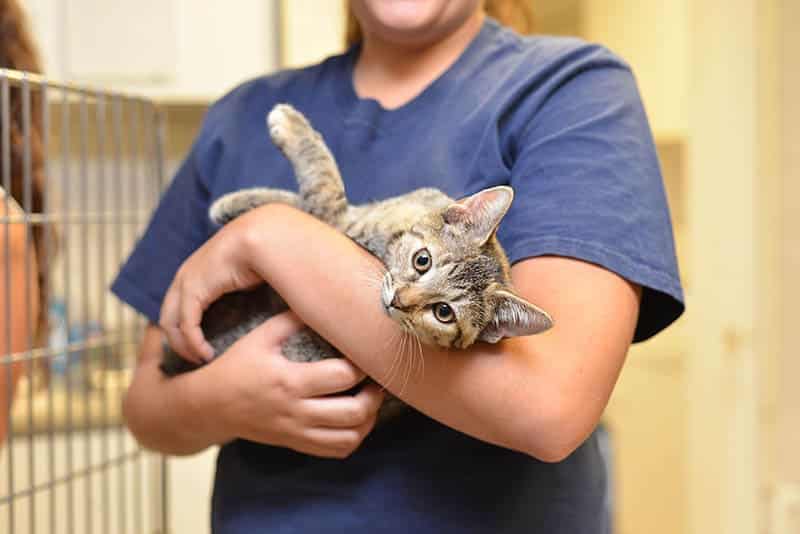Encountering a lost cat can be both a heartwarming and concerning experience. While seeing a cat in distress is upsetting, it also presents an opportunity to help reunite them with their worried owners. Acting swiftly and effectively is crucial when you come across a lost cat. This article serves as a comprehensive guide for taking the right steps to ensure the well-being and safe return of the lost animal. This way, you can significantly increase the chances of reuniting the cat with their rightful home and providing peace of mind to both the owner and the lost pet.
The 11 Steps to Follow If You Find a Lost Cat
1. Assess the Situation
Upon finding a lost cat, observe their behavior and surroundings to assess any immediate dangers or concerns. Keep calm, and avoid sudden movements to prevent scaring away the cat.
2. Approach With Caution
Approach the cat slowly and gently, using a soft, calm, and reassuring voice. Extend your hand for the cat to sniff, and allow them to approach you at their own pace.
3. Check for Identification
Once you can get close to the cat, check them for identification on their tags or collar. If they have this information, contact the owner immediately and arrange for a safe return. If they don’t have tags, they might be microchipped, in which case, you’ll need to take them to a shelter or rescue to be scanned.

4. Safely Secure the Cat
Secure the cat using a carrier, towel, or blanket so they don’t run off or attack you. Be cautious to prevent harm to yourself or the cat during the process. Wear heavy clothing and gloves to protect yourself from scratches.
5. Provide Temporary Shelter
Bring the cat to a safe and quiet space indoors, away from other animals or loud noises. Provide food, water, and a litter box to meet their basic needs and help them feel more comfortable until you can find their owner.
6. Reach Out to Local Animal Shelters and Veterinarians
If you haven’t already, contact nearby animal shelters, veterinary clinics, and rescue organizations about the cat. If the cat isn’t microchipped, you’ll need to provide a description and any relevant details to help them find the owner. The good news is that the owner will likely contact these organizations when searching for their cat.

Create posters with a clear photo and description of the cat, along with your contact information and where you found the animal if there is enough room. Place the posters in the neighborhood and community bulletin boards to raise awareness and catch the owner’s attention.
8. Use Online Lost-and-Found Pet Platforms
Utilize online platforms and websites specifically designed for lost-and-found pets. Post information about the found cat, including photos and contact details, to expand the search efforts.
9. Use Social Media
Social media is a great way to let the people in your area know that you have found a lost cat. News can spread quickly on these platforms, so share images and other information to help spread the word.

10. Spread the Word in the Community
Inform neighbors, mail carriers, and local businesses about the found cat. Share details through community groups to reach a wider audience, and use bulletin boards in stores, banks, and other locations to post information about the cat.
11. Follow Up and Assist With Reunion
Keep in touch with local shelters, veterinarians, and individuals who might have information on the cat’s owner. Once you find the owner, offer assistance with the reunion, such as meeting up at a vet clinic or pet store.

What If I Can’t Find the Owner?
- Contact local animal shelters and rescue organizations to inform them about the situation and see if they have space to take in the cat. They may be able to provide temporary shelter and eventually find the cat a new home.
- Take clear photos of the cat, and create an adoption listing on online platforms or social media groups dedicated to pet adoption. Include a description of the cat’s personality, any unique characteristics, and your contact information.
- Inform your local veterinary clinic about the situation, and ask if they can assist in finding a new home for the cat. They may have contact with individuals or organizations looking to adopt a pet.
- If you cannot keep the cat permanently, consider fostering them temporarily until you find a suitable permanent home. Contact local rescue groups or foster networks to explore this option.
- Continue to monitor online platforms and databases for any reports of lost cats matching the description. Someone may eventually come forward looking for their lost pet.
- Keep the cat, provide them with a nice home, and receive a loving companion in return.
Summary
Finding a lost cat can be an upsetting experience, but their owner is likely looking everywhere for them, so follow the tips in this article to make yourself as visible as possible for the best chance of reuniting them. Social media works amazingly well if the cat has no identification or microchip. Many owners will also call local veterinarians and animal shelters looking for lost pets, so let them know that you have one.
Featured Image Credit: Aaron Zimmermann, Shutterstock
Contents
- The 11 Steps to Follow If You Find a Lost Cat
- 1. Assess the Situation
- 2. Approach With Caution
- 3. Check for Identification
- 4. Safely Secure the Cat
- 5. Provide Temporary Shelter
- 6. Reach Out to Local Animal Shelters and Veterinarians
- 7. Create and Share “Found Cat” Posters
- 8. Use Online Lost-and-Found Pet Platforms
- 9. Use Social Media
- 10. Spread the Word in the Community
- 11. Follow Up and Assist With Reunion
- What If I Can’t Find the Owner?
- Summary











